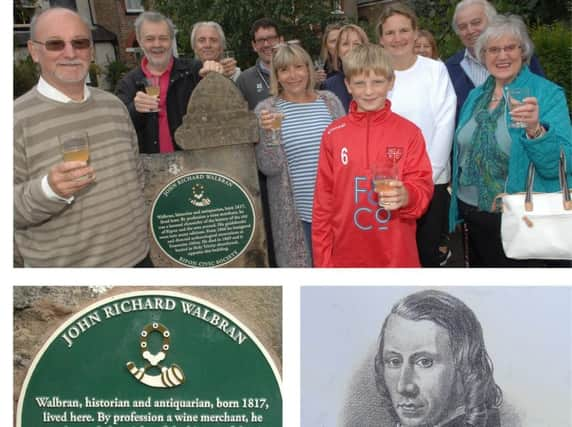Civic Society unveils permanent tribute to Ripon historian and former mayor


The Society's newest green plaque can be seen at Fall Croft - the former home of pioneering Ripon historian John Walbran, who served the city twice as mayor.
Members and supporters of Ripon Civic Society gathered for the official unveiling of the plaque on Saturday, joined by the National Trust’s Justin Scully, who is the general manager at Fountains Abbey and Studley Royal.
Advertisement
Hide AdAdvertisement
Hide AdThe National Trust made a generous donation towards the cost of the plaque to mark Walbran’s work at Fountains Abbey.
The Chairman of Ripon Civic Society, David Winpenny, said: "John Walbran deserves our thanks for his pioneering work in the history of the Ripon area – work from which we are still benefiting.
"The Society is proud to put in place this plaque drawing the attention of local people and visitors to his work in the city and at Fountains Abbey, and we are very grateful to the National Trust for their help."
John Walbran was born on December 24, 1817. From an early age he was fascinated by the past and wanted to devote his life to antiquarian study, but his parents were not encouraging.
Advertisement
Hide AdAdvertisement
Hide AdHe went to work for his family's wine firm, but devoted all his spare time to history. In 1837, aged just 19, Walbran published the first edition of his best-known work, his Guide to Ripon, Fountains Abbey, Harrogate, Bolton Abbey and Several Places of Interest in their Vicinity.
He became the local secretary of the British (later Royal) Archaeological Society, and he was also elected to Ripon City Council, serving twice as mayor.
Walbran considered his most important work to be The Memorials of Fountains, for which he did vast amounts of research but managed to publish only one of the projected two volumes.
In 1848 the Earl de Grey asked Walbran to supervise the clearing of the Fountains Abbey site; his workmen removed heaps of spoil, using a small railway.
Advertisement
Hide AdAdvertisement
Hide AdExplaining the significance of honouring Walbran's contribution to Ripon, the Civic Society said: "Much of what we know of Fountains Abbey today - and quite a lot of what we can see, is due to Walbran’s diligent and, for its time, careful excavations over several years."
Walbran died on April 7 1868, and he was buried in the churchyard of Holy Trinity Church - just opposite his house at Fall Croft where the new plaque is located.